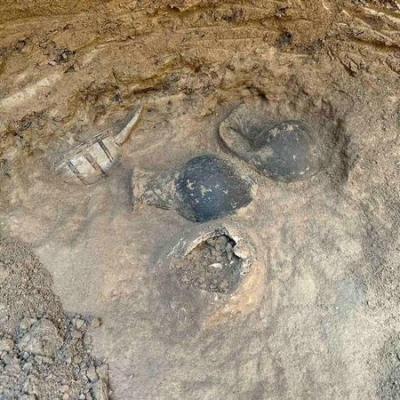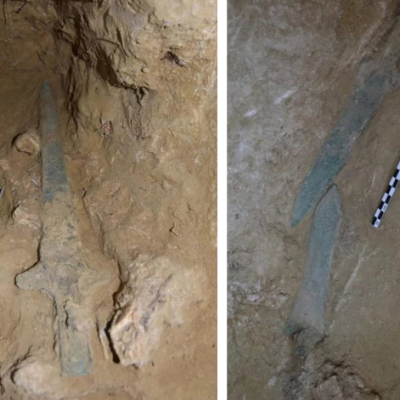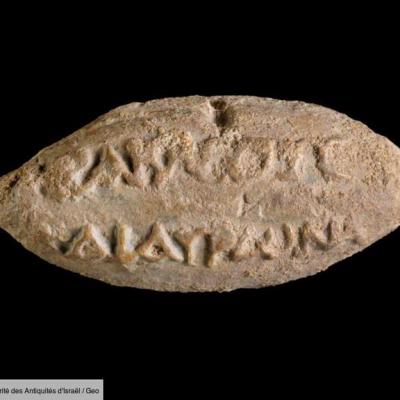INSTITUT SUPERIEUR D'ANTHROPOLOGIE
INSTITUTE OF ANTHROPOLOGY
ONLINE COURSES / COURS A DISTANCE
DEBUT COURS : AVRIL 2023
REGISTER NOW
CHYPRE –  Limassol - Excavation work carried out as part of a flood protection project in the centre of Limassol has unearthed an ancient tomb. The Limassol-Amathus Sewerage Board said the tomb dates back to the Late Bronze Age (1600-1050 BC). To date, two human skeletons and various offerings (vessels) have been found inside it. According to the Department of Antiquities, digs to reveal the findings are expected to last until March 17.
Limassol - Excavation work carried out as part of a flood protection project in the centre of Limassol has unearthed an ancient tomb. The Limassol-Amathus Sewerage Board said the tomb dates back to the Late Bronze Age (1600-1050 BC). To date, two human skeletons and various offerings (vessels) have been found inside it. According to the Department of Antiquities, digs to reveal the findings are expected to last until March 17.
https://www.financialmirror.com/2023/03/15/ancient-tomb-in-limassol-discovered/
SUISSE – 

 Ammertenhorn - Situated between snow-capped peaks in the Swiss Alps sits a rocky plateau. Those who make the difficult trek up find themselves rewarded with the plateau’s stunning and awe-inspiring view. As archaeologists found, it’s a view that people have been admiring for millennia. The plateau is part of the Ammertenhorn mountain in Switzerland. Archaeologists returned to the plateau and found a collection of Roman artifacts, city officials said. Excavations uncovered hundreds of Roman coins intermixed with 27 rock crystals. Photos show a few of these items. A bronze leaf-shaped fragment with a punch-marked design was also unearthed, a photo shows. Experts identified this as an offering made to fulfill a vow.But why did people climb this peak and leave offerings 2,000 years ago? Archaeologists believe this plateau was a holy site, possibly treated as a pilgrimage site, the release said. The types of artifacts unearthed are similar to offerings left at other Roman religious sites. Down the mountain from the plateau, archaeologists previously found a Roman sanctuary, officials said. An inscription at the Thun-Allmendingen sanctuary describes how locals left offerings to an Alpine goddess to appease, thank or ask something of her.
Ammertenhorn - Situated between snow-capped peaks in the Swiss Alps sits a rocky plateau. Those who make the difficult trek up find themselves rewarded with the plateau’s stunning and awe-inspiring view. As archaeologists found, it’s a view that people have been admiring for millennia. The plateau is part of the Ammertenhorn mountain in Switzerland. Archaeologists returned to the plateau and found a collection of Roman artifacts, city officials said. Excavations uncovered hundreds of Roman coins intermixed with 27 rock crystals. Photos show a few of these items. A bronze leaf-shaped fragment with a punch-marked design was also unearthed, a photo shows. Experts identified this as an offering made to fulfill a vow.But why did people climb this peak and leave offerings 2,000 years ago? Archaeologists believe this plateau was a holy site, possibly treated as a pilgrimage site, the release said. The types of artifacts unearthed are similar to offerings left at other Roman religious sites. Down the mountain from the plateau, archaeologists previously found a Roman sanctuary, officials said. An inscription at the Thun-Allmendingen sanctuary describes how locals left offerings to an Alpine goddess to appease, thank or ask something of her.
https://www.heraldonline.com/news/nationworld/world/article273148170.html#storylink=cpy
INDE –  Keeladi - For the first time since excavations began there in 2020, archaeologists have found huge quantities of carnelian beads and husks from burial urns in Konthagai in the just-concluded third season, which could further help establish that it was here the inhabitants of Keeladi, the Sangam-era site near Madurai, were buried. As many as 59 urns in different size and shape like red ware, red ware with black and red ware lid, red slipped ware, and black and red ware were unearthed by the Tamil Nadu State Department of Archaeology (TNSDA) in the 2021-2022 season concluded in September last year with 216 offering pots found inside them. Significant finds from inside the urns are huge quantities of carnelian beads and nearly one kg of husk. The carnelian beads, which are 79 in number, are similar to those found in the excavations in Keeladi providing yet another evidence to suggest that its inhabitants were buried in Konthagai, which is located around 800 metres from the habitation site. “We have been looking for husks since 2020 but this is the first time we found them, that too almost one kg. When we send this for dating, we are likely to make yet another progress as husks reveal the period of the site,” the source added. It was paddy husks found in Sivakalai, another archaeological site on the banks of river Porunai in Thoothukudi district, that established its period to be 3,200 years old. Husks are usually found in the offering pots that are placed inside the urns while burying the dead. The sources said 20 human samples found in the 59 urns unearthed this season have already been sent for ancient DNA analysis to be conducted at the new lab established at the Madurai Kamaraj University (MKU). Archaeologists said they also found eight iron implements from burial urns of which five are sword, two chisel, and one axe during the third season of excavations in Konthagai. The fourth round of excavations in Konthagai and ninth round in Keeladi will begin in the next few days.
Keeladi - For the first time since excavations began there in 2020, archaeologists have found huge quantities of carnelian beads and husks from burial urns in Konthagai in the just-concluded third season, which could further help establish that it was here the inhabitants of Keeladi, the Sangam-era site near Madurai, were buried. As many as 59 urns in different size and shape like red ware, red ware with black and red ware lid, red slipped ware, and black and red ware were unearthed by the Tamil Nadu State Department of Archaeology (TNSDA) in the 2021-2022 season concluded in September last year with 216 offering pots found inside them. Significant finds from inside the urns are huge quantities of carnelian beads and nearly one kg of husk. The carnelian beads, which are 79 in number, are similar to those found in the excavations in Keeladi providing yet another evidence to suggest that its inhabitants were buried in Konthagai, which is located around 800 metres from the habitation site. “We have been looking for husks since 2020 but this is the first time we found them, that too almost one kg. When we send this for dating, we are likely to make yet another progress as husks reveal the period of the site,” the source added. It was paddy husks found in Sivakalai, another archaeological site on the banks of river Porunai in Thoothukudi district, that established its period to be 3,200 years old. Husks are usually found in the offering pots that are placed inside the urns while burying the dead. The sources said 20 human samples found in the 59 urns unearthed this season have already been sent for ancient DNA analysis to be conducted at the new lab established at the Madurai Kamaraj University (MKU). Archaeologists said they also found eight iron implements from burial urns of which five are sword, two chisel, and one axe during the third season of excavations in Konthagai. The fourth round of excavations in Konthagai and ninth round in Keeladi will begin in the next few days.
https://www.deccanherald.com/national/south/carnelian-beads-and-husks-found-in-urns-in-keeladi-cluster-site-1200289.html
INDE - Alagankulam - A report from the state archaeological department on whether any further excavations would be conducted at Alagankulam village in Ramanathapuram district. Alagankulam, which is situated on the east coast of the district, is believed to have been an important trade centre or port city during the Sangam Era. Many antiquities and structures, which could go a long way in proving the existence of ancient urban Tamil civilization, were unearthed during the excavations conducted in Alagankulam village from 1980 to 2017.
https://www.newindianexpress.com/states/tamil-nadu/2023/mar/15/report-sought-on-possibility-of-further-excavations-in-alagankulam-2556063.html
GRECE –  Rypes – Archaeologists have uncovered three bronze swords from the Mycenaean civilisation during excavations of q 12th to 11th century BC tomb, discovered on the Trapeza Plateau in the Peloponnese. The tomb was found in a Mycenaean necropolis located in the ancient settlement of Rypes, where numerous chambered tombs were carved into the sandy subsoil during the “first palace” period of the Mycenaean era. Archaeological evidence suggests that the tombs were repeatedly reopened for burial customs and complex ritual practices until the end of the Bronze Age during the 11th century BC. Excavations of the necropolis have revealed numerous vases, necklaces, golden wreaths, seal stones, beads, and pieces of glass, faience, gold, and rock crystal. In the latest excavation, the researchers have been exploring a rectangular shaped tomb that contains three 12th century BC burials adorned with false-mouth amphorae. Among the remains are offerings of glass beads, cornaline and a clay horse figurine, in addition to three bronze swords with part of their wooden handles still preserved. All three swords belong to different type-set classifications, being D and E of the “Sandars typology”, which date to the Mycenaean palace period. In the typology, D type swords are typically described as “cross” swords, while class E are described as “T-hilt” swords. Excavations have also found part of the settlement in the vicinity of the tombs, revealing part of a high-status building with a rectangular room containing a hearth in the centre.
Rypes – Archaeologists have uncovered three bronze swords from the Mycenaean civilisation during excavations of q 12th to 11th century BC tomb, discovered on the Trapeza Plateau in the Peloponnese. The tomb was found in a Mycenaean necropolis located in the ancient settlement of Rypes, where numerous chambered tombs were carved into the sandy subsoil during the “first palace” period of the Mycenaean era. Archaeological evidence suggests that the tombs were repeatedly reopened for burial customs and complex ritual practices until the end of the Bronze Age during the 11th century BC. Excavations of the necropolis have revealed numerous vases, necklaces, golden wreaths, seal stones, beads, and pieces of glass, faience, gold, and rock crystal. In the latest excavation, the researchers have been exploring a rectangular shaped tomb that contains three 12th century BC burials adorned with false-mouth amphorae. Among the remains are offerings of glass beads, cornaline and a clay horse figurine, in addition to three bronze swords with part of their wooden handles still preserved. All three swords belong to different type-set classifications, being D and E of the “Sandars typology”, which date to the Mycenaean palace period. In the typology, D type swords are typically described as “cross” swords, while class E are described as “T-hilt” swords. Excavations have also found part of the settlement in the vicinity of the tombs, revealing part of a high-status building with a rectangular room containing a hearth in the centre.
https://www.heritagedaily.com/2023/03/bronze-swords-from-mycenaean-civilisation-found-in-greek-tomb/146520
PEROU –  Pakaytambo - C'est sur le site de Pakaytambo, dans le sud du pays les hautes terres andines et les vallées côtières d'Arequipa, que les archéologues ont découvert plusieurs temples Wari vieux de 1.200 ans, relaye The Art Newspaper. Au sein de ce vaste complexe millénaire, les recherches ont révélé la présence d'un temple en forme de "D", surélevé sur une plateforme monumentale, avec des structures adjacentes en contrebas dans lesquelles des fonctionnaires et responsables religieux de l'empire Wari auraient vécu. Les places, salles et patios mis en évidence par les fouilles ont permis de reconstituer certains modes de vie. "Des espaces ouverts associés au complexe du temple de Pakaytambo auraient permis aux communautés locales de participer à des rassemblements rituels organisés par les Wari", a déclaré David Reid, chercheur postdoctoral à l'Université de l'Illinois à Chicago, dans l'étude publiée le 10 janvier dernier dans le Journal of Anthropological Archaeology. Aujourd'hui, une grande partie du temple est recouverte des cendres d'une éruption volcanique datant de 1600. La civilisation pré-Incas Wari, qui prospéra entre l'an 600 et 1.200, contrôlaient de grandes parties du Pérou moderne en déployant des tactiques militaires et commerciales. "Les recherches archéologiques menées au centre du temple de Pakaytambo, récemment découvert, fournissent la première preuve concluante d'une présence impériale Wari intrusive dans la région Majes-Chuquibamba d'Arequipa, au Pérou", suggère Reid. Mais surtout, cette découverte aide à comprendre le rôle de ces temples dans l'expansion de l'Empire Wari. "Au centre du temple Pakaytambo, et dans d'autres complexes rituels Wari récemment identifiés au Pérou, nous avons également de plus en plus de preuves que les Wari ont incorporé des gens dans l'empire par le biais de croyances religieuses partagées et d'événements cérémoniels à grande échelle organisés par les élites Wari", poursuit l'expert. Comme l'explique The Art Newspaper, des investigations supplémentaires permettront de déterminer plus précisément la durée pendant laquelle les Wari ont utilisé le Pakaytambo, et de savoir quels types de rituels et cérémonies ont véritablement eu lieu entre ses murs.
Pakaytambo - C'est sur le site de Pakaytambo, dans le sud du pays les hautes terres andines et les vallées côtières d'Arequipa, que les archéologues ont découvert plusieurs temples Wari vieux de 1.200 ans, relaye The Art Newspaper. Au sein de ce vaste complexe millénaire, les recherches ont révélé la présence d'un temple en forme de "D", surélevé sur une plateforme monumentale, avec des structures adjacentes en contrebas dans lesquelles des fonctionnaires et responsables religieux de l'empire Wari auraient vécu. Les places, salles et patios mis en évidence par les fouilles ont permis de reconstituer certains modes de vie. "Des espaces ouverts associés au complexe du temple de Pakaytambo auraient permis aux communautés locales de participer à des rassemblements rituels organisés par les Wari", a déclaré David Reid, chercheur postdoctoral à l'Université de l'Illinois à Chicago, dans l'étude publiée le 10 janvier dernier dans le Journal of Anthropological Archaeology. Aujourd'hui, une grande partie du temple est recouverte des cendres d'une éruption volcanique datant de 1600. La civilisation pré-Incas Wari, qui prospéra entre l'an 600 et 1.200, contrôlaient de grandes parties du Pérou moderne en déployant des tactiques militaires et commerciales. "Les recherches archéologiques menées au centre du temple de Pakaytambo, récemment découvert, fournissent la première preuve concluante d'une présence impériale Wari intrusive dans la région Majes-Chuquibamba d'Arequipa, au Pérou", suggère Reid. Mais surtout, cette découverte aide à comprendre le rôle de ces temples dans l'expansion de l'Empire Wari. "Au centre du temple Pakaytambo, et dans d'autres complexes rituels Wari récemment identifiés au Pérou, nous avons également de plus en plus de preuves que les Wari ont incorporé des gens dans l'empire par le biais de croyances religieuses partagées et d'événements cérémoniels à grande échelle organisés par les élites Wari", poursuit l'expert. Comme l'explique The Art Newspaper, des investigations supplémentaires permettront de déterminer plus précisément la durée pendant laquelle les Wari ont utilisé le Pakaytambo, et de savoir quels types de rituels et cérémonies ont véritablement eu lieu entre ses murs.
Pérou : l'incroyable découverte d'une équipe d'archéologues (caminteresse.fr)
ISRAEL –  Yavné - Les archéologues ont fait une rare découverte sur le site de fouilles de Yavné, en Israël. L'Autorité des antiquités du pays a annoncé avoir trouvé une balle de fronde en plomb de la période hellénistique, sur laquelle a été gravée une inscription en grec destinée à assurer la victoire au combat. Le projectile, vieux de 2.200 ans, pourrait avoir été utilisé par un soldat grec pendant la guerre contre les Hasmonéens. Sur la balle de fronde, on pouvait lire "Victoire d'Héraclès et d'Hauronas". "Les inscriptions faisaient partie de la guerre psychologique. C'est la première fois que l'association de ces deux dieux, Hauronas et Héraclès (plus connu sous le nom d'Hercule), est retrouvée sur un artefact à Yavné. Elle montre que ces derniers "étaient considérés comme les patrons divins de la cité pendant la période hellénistique", entre 323 av. J.-C. et 31 av. J.-C., souligne Yulia Ustinova, qui a déchiffré l'inscription. Jusqu'à présent, ce couple de divinités, qui symbolise la victoire, n'avait été retrouvé que dans une inscription mise au jour sur l'île grecque de Délos. La balle, longue de 4,4 cm, était utilisée dans une fronde ancienne, une arme de jet utilisée depuis le Ve siècle av. J.-C. Rien n'indique qu'elle ait été réellement utilisée, précise le communiqué. Mais elle pourrait être liée au conflit qui opposa les Grecs et les Hasmonéens au IIe siècle avant J.-C.
Yavné - Les archéologues ont fait une rare découverte sur le site de fouilles de Yavné, en Israël. L'Autorité des antiquités du pays a annoncé avoir trouvé une balle de fronde en plomb de la période hellénistique, sur laquelle a été gravée une inscription en grec destinée à assurer la victoire au combat. Le projectile, vieux de 2.200 ans, pourrait avoir été utilisé par un soldat grec pendant la guerre contre les Hasmonéens. Sur la balle de fronde, on pouvait lire "Victoire d'Héraclès et d'Hauronas". "Les inscriptions faisaient partie de la guerre psychologique. C'est la première fois que l'association de ces deux dieux, Hauronas et Héraclès (plus connu sous le nom d'Hercule), est retrouvée sur un artefact à Yavné. Elle montre que ces derniers "étaient considérés comme les patrons divins de la cité pendant la période hellénistique", entre 323 av. J.-C. et 31 av. J.-C., souligne Yulia Ustinova, qui a déchiffré l'inscription. Jusqu'à présent, ce couple de divinités, qui symbolise la victoire, n'avait été retrouvé que dans une inscription mise au jour sur l'île grecque de Délos. La balle, longue de 4,4 cm, était utilisée dans une fronde ancienne, une arme de jet utilisée depuis le Ve siècle av. J.-C. Rien n'indique qu'elle ait été réellement utilisée, précise le communiqué. Mais elle pourrait être liée au conflit qui opposa les Grecs et les Hasmonéens au IIe siècle avant J.-C.
Israël : découverte d'un projectile rare portant une inscription magique, vieux de 2.200 ans (msn.com)